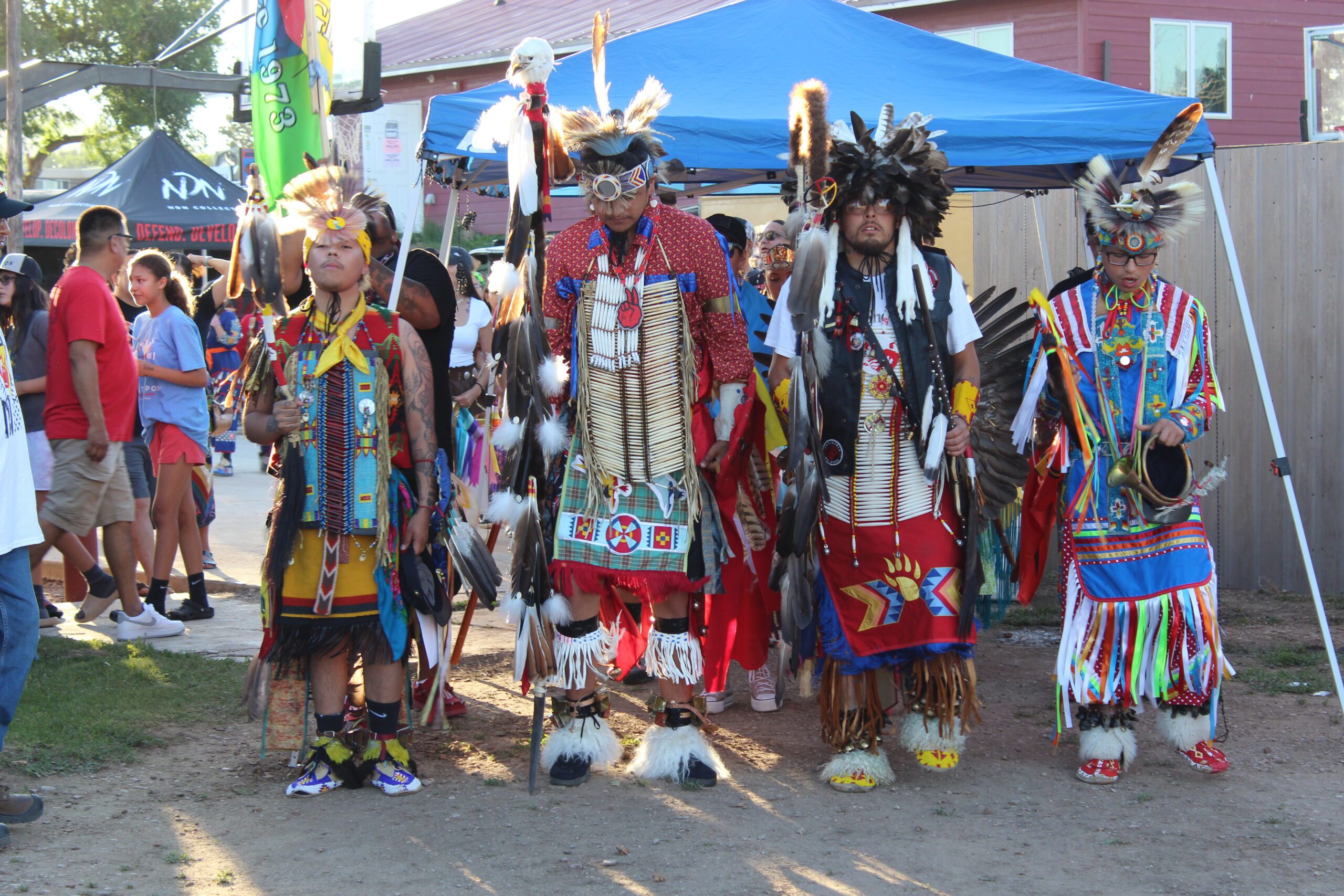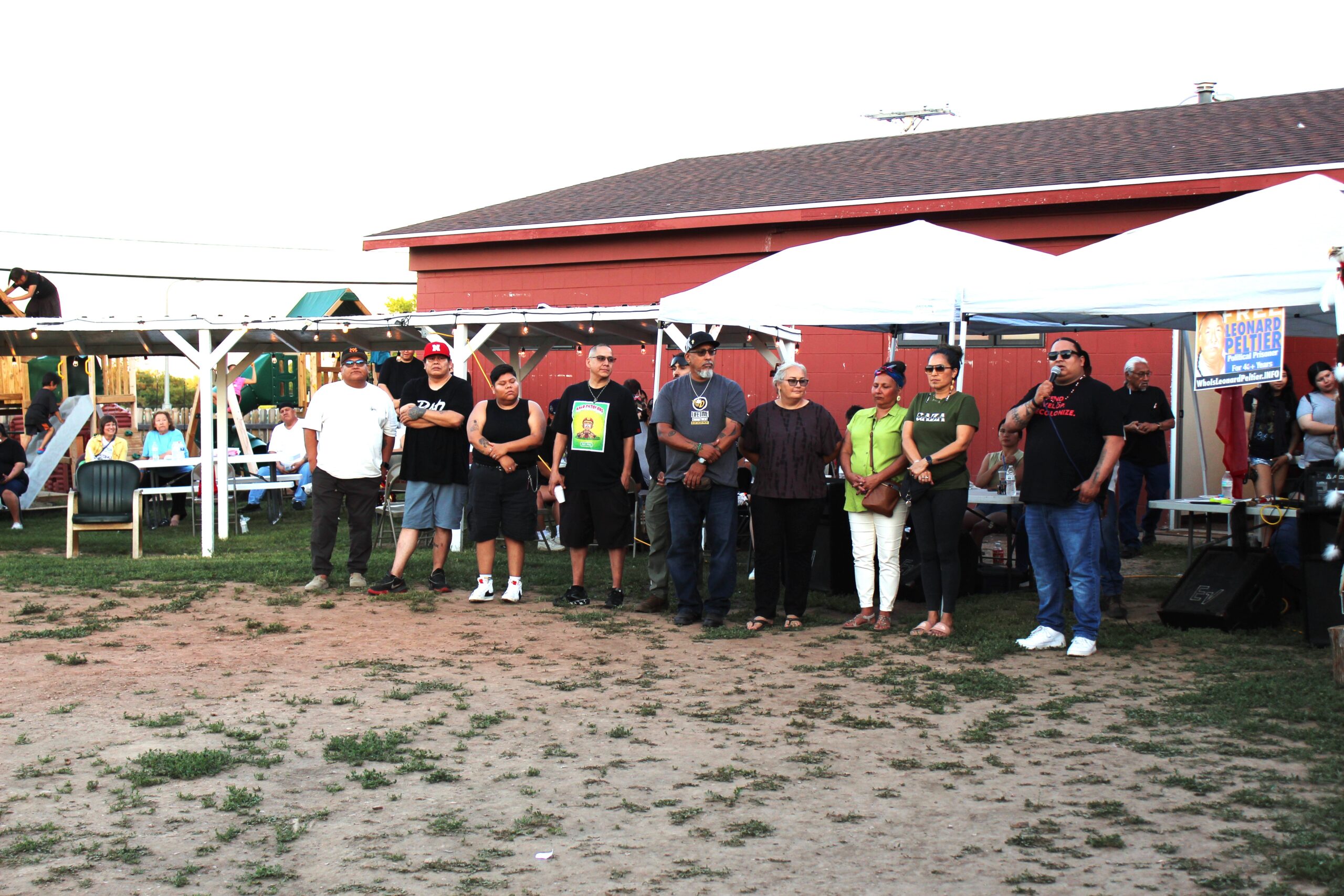Rapid City celebrates inaugural Battle of Greasy Grass Victory Day

Grand entry at the inaugeral Battle of Greasy Grass Mniluzahan Victory Day Commemoration held at Woyatan Church powwow grounds. (Photo by Ernestine Anunkasan Hopa)
RAPID CITY – There may be efforts to wipe the history books clean of the genocidal assault on Native Americans, but Native Americans will never forget because to heal from the past, the past must be remembered and acknowledged.
Organizers of the first annual Battle of Greasy Grass Mniluzahan Victory Day Commemoration held at Woyatan on Wednesday invited the community to share a meal, sing, dance and celebrate what was a victorious day in the history of the Oceti Sakowin.
It was muggy and warm day as people in Rapid City gathered to celebrate together. Thunderheads looked like they might dump some rain but shifted away. Children and adults played basketball. Native Americans and non-Native Americans gathered to share the meal. So many came, the fry bread ran out. The kitchen still had all the fixin’s for Indian tacos and so quick thinkers replaced the fry bread with tortilla chips.
The victory celebration of this historic battle is one that takes place on many of the reservations in the region. But just as this history has been suppressed and manipulated in its retelling, many still are unaware of it.
“A lot of the Rapid City community don’t know the full history, but many also don’t have the means to make it to all the other events on the reservations or in Montana, so we want to bring the celebration to them,” said Hermus Bettelyoun, a local organizer for NDN Collective. “This isn’t really taught in the school system. A lot of the stories are not told but need to be told. So, if they aren’t going to teach in that system, then we will teach them here. All the battles from the signing of the treaties to Greasy Grass to the Wounded Knee massacre, they are all connected and since they aren’t really taught it’s difficult to connect those timelines.”
The Battle of Greasy Grass is also known as the Battle of the Little Bighorn as well as Custer’s Last Stand. The story has been retold as the death of an American hero; an “Indian fighter” who is said to have distinguished himself in the Civil War. Custer was named acting commander of the newly formed 7th Cavalry Regiment and was called to western Kansas to help Major General Winfield S. Hancock threaten the Plains Indians with the strength of U.S. military force.
But the real George Armstrong Custer was not hero material. He graduated dead last in his class from the West Point Military Academy. According to the retelling in Britannica, Custer was unable to “adapt successfully to Indian warfare” and began to behave unexpectedly, ordering that deserters be shot without trial and then abandoned his regiment so he could visit his wife. His pay and rank were suspended temporarily after he was court-martialed and found guilty of misconduct. His recklessness was not a consideration. It was his reputation as being “aggressive” that convinced his superiors to give him a second chance.
It was his surprise attack on Chief Black Kettle’s village of Southern Cheyenne on the Washita River that solidified his reputation as an “Indian” fighter. The village was destroyed and the estimated 103 who were killed were thought to be mostly women, children and older people. This after Black Kettle’s people had already been the victims of the Sand Creek Massacre of 1864.
In 1868, the U.S. government signed a treaty recognizing that the Black Hills area was the sacred hunting grounds of the Oceti Sakowin and would be a part of the Great Sioux Nation Reservation. But by 1874 there were rumors of gold in the Black Hills, so the government violated the treaty by ordering Custer to look for gold in the Black Hills. General Philip Sheridan, according to PBS’s American Experience, was hoping the treaty violation would antagonize Indians and spark a new war so the government could force them all back onto the reservations. The government did nothing about the miners who were pouring into the Black Hills. Eventually, thousands of Indians left their reservations to join Chief Sitting Bull along the Upper Yellowstone River.

A delegation from Hawaii at the first annual Battle of Greasy Grass Mniluzahan Victory Day Commemoration. Speaking is NDN Collective Executive Director Nick Tielson. (Photo by Ernestine Anunkasan Hopa)
The Battle of Greasy Grass was an overwhelming victory for the Lakota, Northern Cheyenne and Arapahoe but it is also is the beginning of the end of the Indian Wars as the United States used it as just cause to increase its efforts to force Native Americans onto reservations leaving the lands to use by white settlers.
The government set about separating bands from their nations and children from their parents disenfranchising Native Americans from their language, religion and cultural identity.
“This is an historic, monumental and victorious day for our people. We want to remember our ancestors and honor them in a good way,” said Cante Hart from He Sapa Otipi, one of the events sponsors. “A few of the Miniluzahan Rapid City organizations came together to make this happen.” She thanked Wambli Ska, Dakota AIM Grass Roots, COUP Council, NDN Collective, He Sapa Otipi and Oaye Luta Okolakiciye. as well as other organizations who helped to sponsor the event.
“This was historic,” explained Hart, “because it was a time when all of our tribes came together as one, to fight together. And so, it was a monumental day in history. I think there were about 1800 tipis. If you can imagine all our people coming together as one, it’s really good to think that we come from such strong and resilient people. They fought and died for us to be here. The least we can do is honor them today. WE want to remember them and let them know that we are still fighting and we are still here.”
(Contact Marnie Cook cookm8715@gmail.com)
The post Rapid City celebrates inaugural Battle of Greasy Grass Victory Day first appeared on Native Sun News Today.
